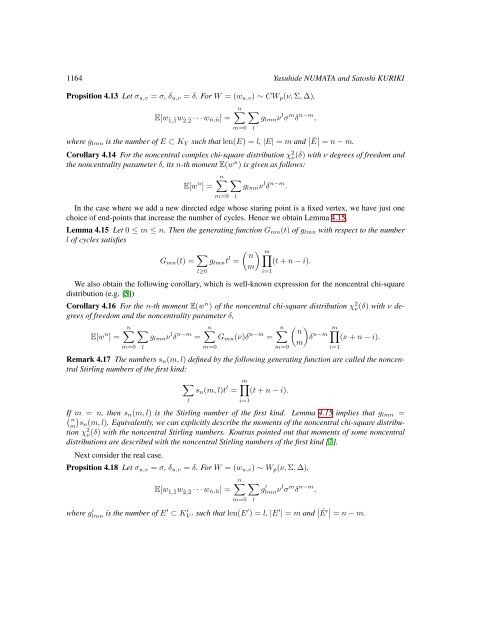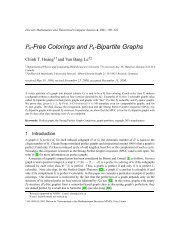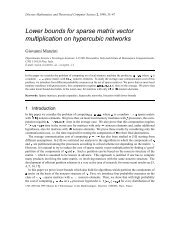On formulas for moments of the Wishart distributions as weighted ...
On formulas for moments of the Wishart distributions as weighted ...
On formulas for moments of the Wishart distributions as weighted ...
You also want an ePaper? Increase the reach of your titles
YUMPU automatically turns print PDFs into web optimized ePapers that Google loves.
1164 Y<strong>as</strong>uhide NUMATA and Satoshi KURIKI<br />
Propsition 4.13 Let σ u,v = σ, δ u,v = δ. For W = (w u,v ) ∼ CW p (ν, Σ, ∆),<br />
n∑<br />
E[w˙1,¨1 w˙2,¨2 · · · w ∑<br />
ṅ,¨n] = g lmn ν l σ m δ n−m ,<br />
where g lmn is <strong>the</strong> number <strong>of</strong> E ⊂ K V such that len(E) = l, |E| = m and ∣ ∣ Ě ∣ ∣ = n − m.<br />
m=0<br />
Corollary 4.14 For <strong>the</strong> noncentral complex chi-square distribution χ 2 ν(δ) with ν degrees <strong>of</strong> freedom and<br />
<strong>the</strong> noncentrality parameter δ, its n-th moment E(w n ) is given <strong>as</strong> follows:<br />
n∑ ∑<br />
E[w n ] = g lmn ν l δ n−m .<br />
m=0<br />
In <strong>the</strong> c<strong>as</strong>e where we add a new directed edge whose staring point is a fixed vertex, we have just one<br />
choice <strong>of</strong> end-points that incre<strong>as</strong>e <strong>the</strong> number <strong>of</strong> cycles. Hence we obtain Lemma 4.15.<br />
l<br />
Lemma 4.15 Let 0 ≤ m ≤ n. Then <strong>the</strong> generating function G mn (t) <strong>of</strong> g lmn with respect to <strong>the</strong> number<br />
l <strong>of</strong> cycles satisfies<br />
G mn (t) = ∑ ( ) n ∏ m<br />
g lmn t l = (t + n − i).<br />
m<br />
l≥0<br />
i=1<br />
We also obtain <strong>the</strong> following corollary, which is well-known expression <strong>for</strong> <strong>the</strong> noncentral chi-square<br />
distribution (e.g. [5])<br />
Corollary 4.16 For <strong>the</strong> n-th moment E(w n ) <strong>of</strong> <strong>the</strong> noncentral chi-square distribution χ 2 ν(δ) with ν degrees<br />
<strong>of</strong> freedom and <strong>the</strong> noncentrality parameter δ,<br />
n∑ ∑<br />
n∑<br />
n∑<br />
( n ∏<br />
E[w n ] = g lmn ν l δ n−m = G mn (ν)δ n−m = δ<br />
m) m n−m (ν + n − i).<br />
m=0<br />
l<br />
m=0<br />
Remark 4.17 The numbers s n (m, l) defined by <strong>the</strong> following generating function are called <strong>the</strong> noncentral<br />
Stirling numbers <strong>of</strong> <strong>the</strong> first kind:<br />
∑<br />
m∏<br />
s n (m, l)t l = (t + n − i).<br />
l<br />
( If m = n, <strong>the</strong>n s n (m, l) is <strong>the</strong> Stirling number <strong>of</strong> <strong>the</strong> first kind. Lemma 4.15 implies that g lmn =<br />
n<br />
)<br />
m sn (m, l). Equivalently, we can explicitly describe <strong>the</strong> <strong>moments</strong> <strong>of</strong> <strong>the</strong> noncentral chi-square distribution<br />
χ 2 ν(δ) with <strong>the</strong> noncentral Stirling numbers. Koutr<strong>as</strong> pointed out that <strong>moments</strong> <strong>of</strong> some noncentral<br />
<strong>distributions</strong> are described with <strong>the</strong> noncentral Stirling numbers <strong>of</strong> <strong>the</strong> first kind [7].<br />
Next consider <strong>the</strong> real c<strong>as</strong>e.<br />
i=1<br />
l<br />
m=0<br />
Propsition 4.18 Let σ u,v = σ, δ u,v = δ. For W = (w u,v ) ∼ W p (ν, Σ, ∆),<br />
n∑<br />
E[w˙1,¨1 w˙2,¨2 · · · w ∑<br />
ṅ,¨n] = g lmnν ′ l σ m δ n−m ,<br />
where g ′ lmn is <strong>the</strong> number <strong>of</strong> E′ ⊂ K ′ V ′ such that len(E′ ) = l, |E ′ | = m and ∣ ∣ Ě ′∣ ∣ = n − m.<br />
m=0<br />
l<br />
i=1






